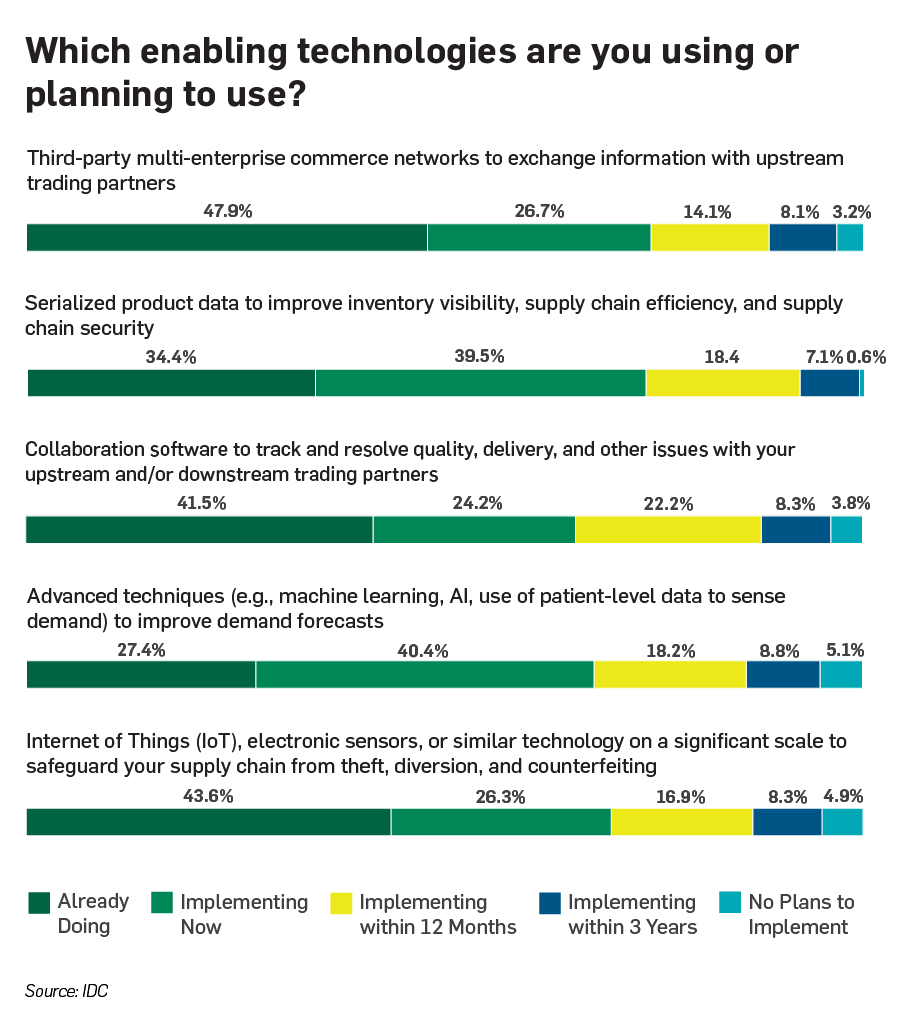Table of contents
Key Takeaways
-
Fewer than half of pharmaceutical supply chain companies have multi-enterprise collaboration tools in place for resolving upstream and downstream supply chain issues.
- The vast majority of pharma supply chain companies are using or planning to use serialized product data to increase supply chain visibility and responsiveness.
- Most companies lack standardized processes for tracking, managing, and resolving upstream and downstream supply chain issues.
October 19, 2020
Companies across the end-to-end pharmaceutical supply chain are increasingly recognizing the value of game-changing enabling technologies—like network collaboration tools, artificial intelligence (AI), and dispenser-level data analytics—that can improve demand forecast accuracy, boost responsiveness and agility in the face of disruptions like COVID-19, and help organizations become more patient-centric, according to the results of a new IDC survey.
I think the laggards are the ones that are stuck in history.
But to be successful, companies need to leverage those enabling technologies to drive actionable visibility and share data more consistently and effectively with upstream and downstream trading partners, warns IDC Program Vice President and Supply Chain Strategies Practice Leader Simon Ellis, who presents the survey results in a new TraceLink webinar.
While some companies are adopting collaboration tools, few of the organizations surveyed are connected to partners in a way that enables seamless information sharing of the critical intelligence needed to make timely decisions and respond effectively to sudden changes in demand.
“The companies who are on this journey to resiliency and to leveraging data‑driven collaborative networks will find themselves well‑served versus companies that do not,” Ellis says. “It's about understanding what kind of visibility is important, and how can I take visibility plus agility plus responsiveness and turn that into a supply chain that can perform better for the patient, but also be more able to react to disruptions.”
Enabling a responsive pharmaceutical supply chain
IDC and TraceLink surveyed more than 500 pharma supply chain companies—including manufacturers, CMOs, wholesalers, and pharmacies—and found that while many respondents recognize the need for network-based collaboration, the industry is lagging behind in terms of adoption.
Today, less than half of respondents have collaboration tools in place for dealing with upstream and downstream supply chain issues—and less than half are effectively sharing data with trading partners.
The vast majority of respondents—74%—are either using or implementing processes to use serialized product data to increase supply chain visibility. Additional tools that pharma supply chain companies are using or plan to use include machine learning technologies and internet of things (IoT) sensors. The survey found that both upstream and downstream visibility, information-sharing, and issue resolution capabilities are critical pharma supply chain gaps that need to be addressed.
The survey found that both upstream and downstream visibility, information-sharing, and issue resolution capabilities are critical pharma supply chain gaps that need to be addressed.
Today, the pharma industry as a whole lags behind others in the adoption of digital technologies. The top methods for resolving both upstream and downstream supply chain issues are highly manual and time-consuming and include phone, fax, email, and email attachments such as spreadsheets and .pdf files.
IDC recommends that pharma supply chain companies adopt enabling technologies like multi-enterprise networks, network collaboration tools, and dispenser-level analytics to significantly boost responsiveness and reduce their reliance on manual approaches.
About 58% of survey respondents say they lack a standardized process for tracking, collaborating on, and quickly resolving issues with downstream partners. About 59% of respondents say they lack a standardized process for tracking, collaborating on, and quickly resolving issues with upstream partners.
TraceLink Digital Transformation Strategist Roddy Martin, who co-hosts the survey results webinar, added that pharmaceutical supply chain companies have historically taken an “inside-out” and ERP-driven approach to managing the supply chain. But now is the time to change the mental model of supply chain and adopt “outside-in” network strategies to collaborate better and gain an improved understanding of patient demand.
“I think the laggards are the ones that are stuck in history,” Martin said. “They haven't realized yet that, ‘Yeah ...my ERP was good at the time and it integrated the business. But it's not enough to manage my role in the network with partners for the future."
Want to learn more? Watch our on-demand webinar featuring IDC’s Simon Ellis.



